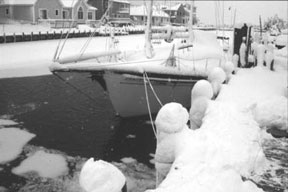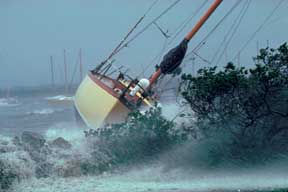Ted Brewer explains how racing rules affected seaworthiness – but not always for the better
The purpose of any rating rule is to enable yachts of different sizes to race together fairly. Without a rating rule there could be no enjoyable racing as, barring unforeseen circumstances, the largest yacht (and the richest owner) would always win. A good example of this is the famous race between the schooner America and the British yachts off the Isle of Wight back in 1851. Due to several disqualifications, a grounding, and a collision, the serious British contenders were eliminated one by one, leaving only the smaller yachts and unwieldy topsail schooners to compete against the trim Yankee upstart. In the end, the 170-ton America finished first, but she was followed across the finish line only 8 minutes later by the 47-ton cutter, Aurora. If there had been any fair type of handicapping system in the race, by tonnage, length, or whatever, present day yachtsmen would be competing for the Aurora’s Cup this year, not the America’s Cup.
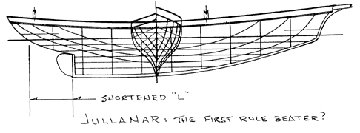
Early attempts at creating rating rules were based on the old British tonnage measurement system, which was created in the Pleistocene era to calculate the tonnage volume of large, commercial sailing ships. It gave the vessel’s carrying capacity in tons (at 35 cubic feet per ton) or, as some believe, in “tuns” (casks of wine). Sail area was not included, of course, nor were any credits given for less efficient rigs so, naturally, in the yacht-racing field the cutters predominated. Eventually, this rule was modified in 1854 as the Thames Measurement Rule: Tons = ((L-B) x B x .5B)/94. (L = length stempost to sternpost and B = maximum beam.) But rigs were still ignored, and the depth measurement was eliminated.
Moved rudder
An easy way to beat such a rule is to shorten the keel measurement, and E. H. Bentall did this with the design of Jullanar in 1875 by moving the rudder radically far forward. (Remember, this moves the sternpost -eds.) Jullanar received a lower rating as a result, won more than her share of races, and was the first of the rule beaters. Because beam was such a large factor in the rule, another way to lower the rating was to make the yachts narrower and narrower. Jullanar was certainly slim, but the rule finally resulted in freaks like the Oona, with a beam 1/6 of her waterline length. Attempts were made to encourage greater beam by the 1881 Yacht Racing Association Rule, ((L + B)² x B)/1730, but the Shona, designed in 1884 by the famous G. L. Watson, was 42 feet overall, 5 feet 9 inches in beam, 6 feet 3 inches in draft, and carried 1,640 square feet of sail!
Small Yachts, by C. P. Kunhardt, published in 1891 and republished by WoodenBoat Publications, Brooklin, Maine, in 1985, shows a number of these narrow beamed, plank-on-edge cutters. One of my favorites is the Spankadillo (what a grand name!), which was 36 feet overall, 30 feet on the waterline, 5 feet in beam, and 6 feet 2 inches in draft. You may be wondering how these skinny cutters could stand up to their tremendous press of sail in a breeze, but the answer is simple: heavy displacement and lots of lead down deep. “Spanky” displaced 19,000 pounds and 12,300 pounds of that was lead – a 65-percent ballast ratio!
Another example, shown in great detail, is the Watson-designed Madge, 46 feet overall x 39 feet 9 inches LWL x 7 feet 9 inches beam x 7 feet 7 inches draft, displacing 39,000 pounds and carrying a lead mine of 23,500 pounds (63.5 percent ratio) on her keel! Unlike many modern yachts, Madge was much more stable right side up than upside down, although her accommodations left a bit to be desired!
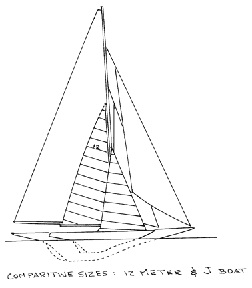
Carried to excess
The British measurement rules and the narrow British cutters never caught on in the U.S., and yachts on this side of the pond developed very differently, having somewhat greater beam and less draft. This was carried to excess in a few cases, as such things always are, and a very beamy 128-foot centerboarder, with sail set, capsized at anchor in New York harbor with some loss of life when several guests were trapped below. However, mainstream American yachts were more conventional and Small Yachts shows plans of a number of craft that are quite practical even by contemporary standards. The 24 foot 6 inch Columbine, and the 25 foot 10 inch Mignonette, are two of my favorites and, even today, they’d be great fun to sail and cruise and would definitely draw envious eyes wherever they sailed.
The racing yachts in the U.S. developed along different lines, unfortunately. The Seawanhaka Yacht Club developed a rating rule in 1882 that placed the emphasis on length and sail area and ignored beam altogether. The result was inevitable; racing yachts became short on the waterline and gained stability by great beam. Perhaps the epitome of this insanity was the Outlook, designed by Starling Burgess, of 52 feet 7 inches LOA, 20 feet 10 inches LWL, 16 feet beam, and 1,800 square feet of sail.
The fin keel was invented about the turn of the century partly in response to this rule, and Captain N. G. Herreshoff designed and built Dilemma, the first successful and well engineered example of the type. Naturally, others designed extreme fin keelers following her success, so the type fell into disrepute when a few poorly engineered boats succumbed to structural problems. In 1902, the New York Yacht Club adopted a rating rule developed by Herreshoff. Its first simple form was Rating = .18 x ((L x SA.5 ) / D.333 ) which became known as the Universal Rule and, by 1906, was quite popular. However, such a simple rule can easily be beaten, so in order to plug the loopholes the rule became more and more complex. Still, it was used well into the 1930s in the J, M, P, and R classes, each with a maximum rating under the rule. I was born too late to get involved with it, but R boats are the smallest, in the 40-foot range, P boats were a little over 50 feet, M boats even larger and J boats huge, 130 feet or so!
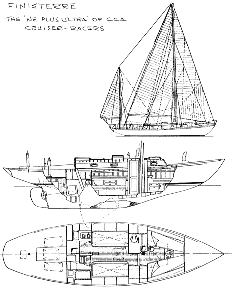
Meter yachts
Men were still working on the other side of the Atlantic to develop a rating rule, and in 1907 they devised a variation of the YRA Rule, called the International Rule. Under it the 6-, 8-, 10-, 12-, and 14-Meter yachts were developed, but readers must note that there is no single measurement in any of these classes that gives them their name. Rather, the rating of “X” meters is developed from a complex formula of measurements taken off the yacht and, on top of that, there are limitations on beam, draft, mast height, etc. within each class.
Too, the larger yachts such as the 8-, 10-, and 12-Meter boats, were required to have minimal “cruising” accommodations, and all had to be built to scantlings established by Lloyd’s Register of Shipping. These ensure that the yacht is built to reasonable standards of structural strength so that, to my knowledge, not one has ever broken in two as did one of the contenders for the recent America’s Cup nonsense. Indeed, the American Eagle, built by Luders in 1964, was converted to an ocean racer in ’68 and, with Ted Turner as skipper, took part in distance races all over the world from Australia to Europe, with much silverware to her credit. Despite this hard usage, she is still sailing and racing in Newport, R.I., some 36 years after her launching, thanks to the quality ensured by being built to Lloyd’s Rules by superb craftsmen.
I began my distance racing in the late ’50s aboard an 8-Meter, the Vision, on Lake Ontario. You may find it hard to imagine a 48-foot yacht that was steered with a tiller, but those 8s were beautifully balanced craft and a dream to handle.
The old Vision was quite comfortable for a weekend or longer race, with good berths, a workable galley, and an enclosed head. The cruising accommodations on the last of the 12s did leave something to be desired, as I know from experience. I designed the accommodation plan of Eagle, and she had Dacron berth bottoms with 1/4-inch thick mattresses, a sink that had to be taken up and emptied overboard, and a head out in the open in the middle of nowhere. It met the intent of the rule, if not the spirit, and other 12s were similar in an attempt to keep unnecessary weight to a minimum.
Bermuda Rule
Still, the Universal Rule and International Rule yachts were, basically, inshore racers rather than ocean racers so, in 1928, the Bermuda Rule was created. It took in length, beam, sail area, and depth, and had a rig allowance, with yawls rated at 93 percent, and ketches and schooners at 90 percent, of their measured area. L, or length, was measured at a height of 4 percent of the LWL above the LWL, and so was an attempt to eliminate the real freaks with long, overhanging ends. Again, over the years, the rule was changed and became much more complex in order to eliminate the rule beaters. Eventually the Cruising Club of America Rule was the final development. It considered length as the basis for the rating and then had adjustments for beam, draft, displacement, and sail area, plus correction factors for stability and propeller.
At the same time, on the other side of the Atlantic, the Royal Ocean Racing Club developed the RORC Rule for offshore yachts. It had many similarities to the CCA Rule, and certainly a similar intent, but whether it was the rule or tradition, the British ocean racers were always less beamy than their American cousins and favored sloop and cutter, rather than yawl, rigs.
In the ’50s and early ’60s, the CCA Rule used the displacement that the designer calculated from the measurer’s flotation figures, and the rule established the basic stability from the designer’s reported ballast. A credit was given for heavy displacement, and another for a low ballast/displacement ratio, so, naturally, there were designers who were so anxious to win that they might stretch the displacement a pound or two when reporting it, and knock a bit off the ballast at the same time. Too, measuring the flotation of a yacht on a breezy day was less than exact and displacement figures could be off hundreds of pounds as a result. As to stability, one designer of a fiberglass 40-footer used a big, heavy steel pipe for the structural “keel” and was able to reduce the actual ballast as a result, so that particular boat received a nice ballast credit and was very successful.
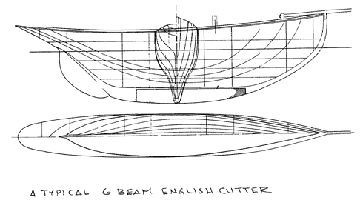
No mainsail
There were many other innovative gambits. Ray Hunt sailed a sloop as a catboat by not setting any headsails and did quite well. Bill Luders sailed Storm without any mainsail and also won his share. I designed a 33-foot schooner, Ingenue, which was rated with a small Bermudian foresail, which she rarely set. Instead, she raced with a huge “fisherman staysail” that set on the foremast sail track, completely filled the space between the masts and overlapped the mainsail like a genoa jib. She gained quite a bit of silver, too, particularly in races where there was a fair amount of offwind work.
One true rule beater was the 1950s Olin Stephens-designed Finisterre. This beamy keel/centerboard yawl took advantage of the rule without really bending it. Her wide beam (moderate by today’s standards), shoal centerboard draft, hefty displacement, modest ballast, and yawl rig combined to give her a favorable rating. Combined with Olin Stephen’s design genius and Carleton Mitchell’s expert handling, she was the boat to beat in any race she entered, and won a room full of trophies. Finisterre’s success inspired a host of keel/centerboard yawls, ranging from Bill Shaw’s lovely little 24-foot MORC racer, Trina, to Bill Tripp’s handsome Block Island 40 and Bermuda 40 and big 50-plus footers such as the beautiful Innishfree, designed by George Cuthbertson, founder of C&C Yachts.
To keep ahead of the tricksters, the CCA committee kept inserting new paragraphs, outlawing most of the rule-beating stunts. By 1967 they had changed the rule so the boat had to be weighed to obtain her displacement, and stability was measured afloat by shifting weights instead of relying on the designer’s often inaccurate ballast figures. The 1967 CCA rule book took about 40 pages to detail the measurements and calculations and to explain the rule.
Very competitive
Despite the rule changes, well designed yachts, such as the keel/centerboarders, and keel yachts, like the Concordia yawls and the Luders 33, remained very competitive in coastal and offshore distance races. However, changes were on the horizon. Bill Lapworth had reinvented the wheel in California with the fast, fin-keel-and-spade-rudder Cal 40, the first largish fin keel yacht since the type died out in the early 1900s.
At first, many East Coast sailors pooh-poohed her as a downwind screamer, best suited to the TransPac and similar off-wind races, but they changed their minds when the swift Cal 40s began to appear on the East Coast in the mid ’60s and started to gobble up the silver. Then, when a Cal 40 won the Bermuda Race in ’66, the rush to fin keel/spade rudder designs was on and the popular keel/centerboard yawl was left in their wake.
In those days, no one really knew which type of fin was the most effective, so there were many weird and wonderful shapes tried for a while, from extremely raked designs to fancily shaped shark fins. Eventually, it turned out that Bill Lapworth had figured it right in the first place, and most cruising boat fins even today (except for the bulb or winged type) are fairly close in lateral profile to the old Cal 40’s squarish fin.
All good things come to an end, though, and so did the CCA Rule. The International Offshore Rule was adopted in 1970 to prevent yachts from having to be remeasured under another rating rule every time they sailed off to race in a foreign country. The early IOR had its faults, of course, and the rule was modified many, many times over the years. Basically, the IOR tried to estimate the displacement of a yacht by measuring beam and depth amidships. The theory was that all sailboats have prismatic coefficients in the .54 to .56 range so, by estimating the midship area you can estimate the displacement. In a very short time, designers were coming up with weird shapes with chines and/or great tumblehome in order to fool the rule into thinking that the midships was bigger and the boat was heavier than its true displacement.
Girth stations
Also, under the IOR the measured length (a major factor, of course) was based on the distance between girth stations, measurements taken at the hull ends. It took two pages in the rule book and a mess of diagrams just to explain how to establish these girth stations, and the whole rule took almost 60 pages to cover the calculations, with some 60 diagrams to explain how and where to measure this and that. Again, designers took advantage of the rule, using extremely pinched ends in order to move the girth stations toward midships and shorten the rated waterline.
It was about this time that I decided I didn’t want to design racing yachts anymore. Actually, I did design one IOR yacht, a 37-footer, which had trim tabs fitted at both the fore and aft ends of her fin keel. Unfortunately for the owner, whose idea it was, the trim tabs were outlawed before she was launched. Oh, well!
The early IOR yachts were rather strange looking to my eyes, as the boats were fairly beamy but the ends, both bow and stern, were very pinched and the deck plan wound up looking like the ace of diamonds. If you see a yacht with a transom that resembles the letter V, then she’s probably an early IOR boat!
The problem with the rule, in my opinion, is that it produced unseaworthy yachts. The CCA boats received a credit for heavy displacement and a credit for moderate ballast. This ensured yachts that were strongly constructed, as weight in the structure was not penalized. Indeed, this helped to lower the rating! The IOR, on the other hand, did nothing to encourage husky construction and, due to their light weight, the boats had insufficient strength and stability. The result was yachts that could not stand up to heavy weather, as was shown in the Fastnet Race in 1979, when so many yachts capsized or foundered, and sailors died.
Equal chances
Since then, the rating system has been changed and many coastal cruisers now race under the Performance Handicap Rating Formula that establishes a rating for a yacht, or a class of yachts, and allows that rating to be altered if the yacht continually wins or loses. The “rule” is an attempt to even out the handicaps, so that every yacht has a chance at the silver if she has good gear, is well sailed, and has her fair share of luck. The PHRF has proven deservedly popular on both East and West Coasts for good reason, as good old boats can have fun racing despite their age and despite how they would have rated under the CCA or IOR formulae.
Unfortunately, serious long-distance ocean racing seems to have left the mainstream of sailing now, and the boats that take part are built regardless of cost, are owned by millionaires and, in many cases, are sailed by well-paid skippers and large crews. The boats are rated under the IMS rule, but I am so completely disinterested in it that I don’t even know what the letters IMS stand for or how the rule works and, Scarlett, I don’t give a damn. (We looked it up: International Measurement System -eds.)
I will not even grace them with the name “yachts” anymore because a yacht is a boat built for pleasure and there is not much pleasure in sailing aboard a modern ocean racer. I’ve been on ocean races where we sang sea chanteys on watch, had a happy hour in the late afternoon, roasts and pies at dinner, and a bottle of good wine to wash it down. We sailed for fun, and we won our share. That’s pleasure, but I doubt if the today’s owners and sailors get any true pleasure out of their sailing, unless they win!
Universal Rule… International Offshore Rule… Thames Measurement Rule… International Rule… Yacht Racing Association Rule… Bermuda Rule… Cruising Club of America Rule… Royal Ocean Racing Club Rule… Seawanhaka Yacht Club Rule… Performance Handicap Racing Formula … International Measurement System…
Article from Good Old Boat magazine, May/June 2000.


